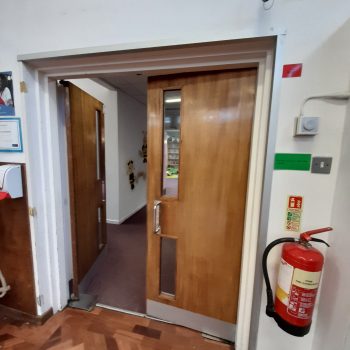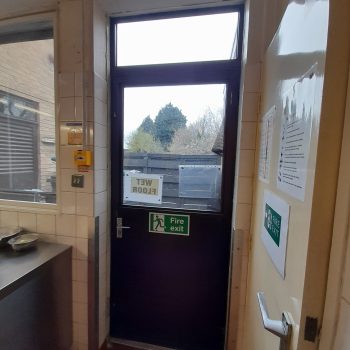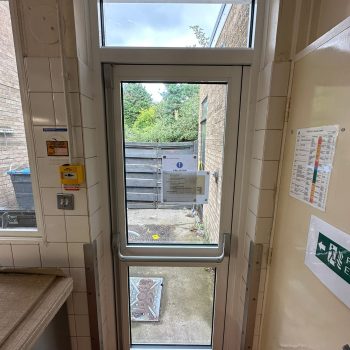Project Overview:
The project involved the installation of FD30 fire-rated doors at a school in Rochford to meet current fire safety standards and ensure the safety of students and staff in the event of a fire emergency. The FD30 fire doors are designed to resist the passage of fire for 30 minutes, offering a critical layer of protection.
Objectives:
- To upgrade the school’s fire safety provisions.
- To install new FD30 fire doors in key areas, including classrooms, corridors, and emergency exits.
- To ensure compliance with fire safety regulations (Regulatory Reform (Fire Safety) Order 2005).
Site Analysis and Planning:
- Survey of Existing Doors: A thorough survey of existing doors and openings was conducted to determine the locations requiring new fire doors. This included identifying areas with inadequate fire resistance.
- Compliance Review: The design and material of the doors were selected to comply with the UK’s building regulations and fire safety codes. Each FD30 door was chosen for its fire resistance capabilities, suitable for high-traffic areas in the school.
- Site Access and Safety: During installation, the school ensured minimal disruption to daily activities. The project team coordinated with school administration to schedule work during non-peak hours or holidays to avoid interruptions.
Installation Process:
- Door Selection and Materials: The new FD30 doors were selected for their proven ability to withstand fire for 30 minutes. Each door was equipped with high-quality hardware, including fire-resistant seals and self-closing mechanisms.
- Preparation and Removal of Old Doors: The installation team carefully removed the old doors and frames, making sure not to damage surrounding structures. Any necessary adjustments to door frames were made to ensure proper fitment of the new FD30 doors.
- Installation of New Doors: The FD30 fire doors were installed with precision to meet fire safety standards. Proper sealing around the edges ensured no gaps, and the doors were fitted with fire-resistant locks, latches, and hinges.
- Testing: After installation, each door was tested for fire resistance. This included checking for proper operation of the self-closing mechanism and verifying that the door seals functioned correctly to prevent the spread of smoke or fire.
- Post-Installation Inspection: Once the doors were installed, a final inspection was carried out by a certified fire safety inspector to confirm that the doors met all fire safety regulations.
Challenges:
- Disruption Management: Ensuring that the installation process caused minimal disruption to the school’s operations, especially given the high foot traffic in certain areas.
- Compatibility with Existing Structure: Some areas required modifications to accommodate the new fire doors, which presented challenges in matching the doors with the existing building design while maintaining fire safety standards.
- Compliance with Regulations: Ensuring that each fire door installation adhered to strict regulatory standards, including ensuring appropriate certification and meeting the fire resistance criteria.
Results and Benefits:
- Enhanced Safety: The installation of FD30 fire doors significantly enhanced the school’s fire safety, providing 30 minutes of fire resistance in key areas, which could be critical in an emergency evacuation.
- Compliance with Legal Requirements: By upgrading the fire doors, the school ensured compliance with local fire safety regulations, mitigating risks and fulfilling its duty of care.
- Improved Emergency Preparedness: The installation of new fire doors contributed to the school’s overall emergency preparedness, ensuring that students and staff could safely evacuate in the event of a fire.
Conclusion:
The successful installation of FD30 fire doors at the school in Rochford improved fire safety across the premises. Through careful planning, execution, and adherence to regulations, the project ensured that the school’s fire protection measures were up to code, safeguarding everyone on site. Future maintenance and regular fire drills will continue to ensure the ongoing effectiveness of the fire safety measures.
Before



After







